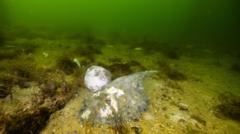In what has been termed a catastrophic "natural disaster" by South Australian Premier Peter Malinauskas, a toxic algae bloom is wreaking havoc along the state's coast. Originating in March, this rapid algal proliferation has grown to encompass an area twice the size of the Australian Capital Territory, turning typically clear waters into a toxic green haze. The federal government has pledged A$14 million ($9 million), but it has stopped short of officially designating the event as a natural disaster, traditionally reserved for major disasters like cyclones or floods.
Authorities have reported the tragic loss of over 400 marine species and have highlighted the devastating impact on local economies. While algal blooms are naturally occurring, their prevalence has been exacerbated by climate change factors, including rising ocean temperatures and nutrient pollution. Premier Malinauskas criticized the government for failing to acknowledge the severity of the situation, noting, "This is a natural disaster and should be acknowledged as such." He also announced plans for an additional A$14 million in funding to support research, cleanup, and industries affected by the bloom.
Criticism of the federal government's response has emerged, notably from Greens Senator Sarah Hanson-Young, who argued that a more immediate response would have occurred had the disaster impacted more affluent areas. Federal Environment Minister Murray Watt described the situation as "incredibly disturbing," yet maintained it did not fulfill the legal definition of a natural disaster.
The bloom, stretching from Coorong to Yorke Peninsula, is lining coastal areas with dead wildlife, further jeopardizing local fisheries. Fishermen have reported significant economic strain, with some unable to generate income for over three months; emotions ran high as one middleman revealed fishermen were often in tears over their dire situation. As the environmental crisis unfolds, calls for urgent action and support for affected communities grow louder, underscoring the imperative to address the root causes tied to climate change.

















